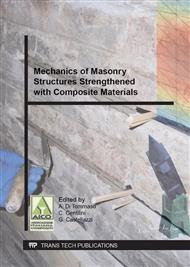[1]
M. Curbach, R. Ortlepp, TRC for Rehabilitation, in: W. Brameshuber (Ed. ), Textile Reinforced Concrete – State-of-the-Art Report of RILEM TC 201-TRC, RILEM Report 36, RILEM Publications S.A.R.L., Bagneux (France), 2006, pp.221-236.
DOI: 10.1617/2351580087.037
Google Scholar
[2]
American Concrete Institute (ACI) Committee 440. Report on fiber-reinforced polymer (FRP) reinforcement for concrete structures – ACI 440R-07. Farmington Hills (MI): ACI; (2007).
DOI: 10.14359/51682411
Google Scholar
[3]
L.A. Bisby, M.F. Green, V.K.R. Kodur, Response to fire of concrete structures that incorporate FRP, Prog Struct Eng Mater, 7 (3) (2005), p.136–149.
DOI: 10.1002/pse.198
Google Scholar
[4]
Foden A, Lyon R, Balaguru P, Davidovitz J. High temperature inorganic resin for use in fiber reinforced composites. In: Saadatmanesh H, Ehsani MR, editors. Proceedings of the 1st international conference on composites in infrastructures, Tucson, AZ, January 15–17, 1996. p.166.
Google Scholar
[5]
K.E.P. Van Balen, S. Ercan, C.T. Patricio, Compatibility and retreatability versus reversibility: a case study at the late hellenistic nymphaeum of Sagalassos (Turkey) L.B. Sickels-Taves (Ed. ), The use of and need for preservation standards in architectural conservation – ASTM STP 1355, American Society for Testing and Materials, West Conshohocken (PA) (1999).
DOI: 10.1520/stp14185s
Google Scholar
[6]
Civil Engineering Research Foundation (CERF). Gap analysis for durability of fiber reinforced polymer composites in civil infrastructure. New York (NY): American Society of Civil Engineers; (2001).
Google Scholar
[7]
Burgoyne C. Fibre reinforced polymers – strengths, weaknesses, opportunities and threats. In: Oehlers D, Griffith M, Seracino R, editors. Proceedings of the 9th international symposium on fiber reinforced polymer reinforcement for concrete structures (FRPRCS-9), Sydney, Australia, 13–15 July (2009).
Google Scholar
[8]
Hammond GP, Jones CI. Inventory of carbon & energy (ICE), version V1. 6a. Bath, UK: Sustainable Energy Research Team, Department of Mechanical Engineering, University of Bath; (2008).
Google Scholar
[9]
De Caso y Basalo FJ, Nanni A, James JP. Qualitative and quantitative environmental impact analysis of BFRC vs GFRP: green building construction rehabilitation systems. In: Engineering sustainability conference. Pittsburgh (PA), April 19–21, (2009).
Google Scholar
[10]
UNI EN 1015–19. Methods of test for mortar for masonry. Determination of flexural and compressive strength of hardened mortar; (1999).
DOI: 10.3403/01905442
Google Scholar
[11]
Papakonstantinou C, Balaguru P. Bond characteristics and structural behavior of inorganic polymer FRP. In: Measuring, monitoring and modeling concrete properties. Dordrecht, Netherlands: Springer Netherlands; 2006. p.735–41.
DOI: 10.1007/978-1-4020-5104-3_89
Google Scholar
[12]
UNI EN 1015–3. Methods of test for mortar for masonry. Determination of consistence of fresh mortar (by flow table); (1999).
DOI: 10.3403/01541440
Google Scholar
[13]
UNI EN 1015–11. Methods of test for mortar for masonry. Determination of flexural and compressive strength of hardened mortar; (1999).
DOI: 10.3403/01905442
Google Scholar
[14]
UNI EN 1015–19. Methods of test for mortar for masonry. Determination of water vapour permeability of hardened rendering and plastering mortars; (2000).
DOI: 10.3403/01541425u
Google Scholar
[15]
UNI EN 1015–18. Methods of test for mortar for masonry. Determination of water absorption coefficient due to capillary action of hardened mortar; (2004).
DOI: 10.3403/02720093u
Google Scholar
[16]
UNI EN 1052–3. Methods of test for masonry. Part 3: determination of initial shear strength; (2003).
Google Scholar
[17]
V. Corinaldesi, Environmentally-friendly bedding mortars for repair of historical buildings, Constr Build Mater 35 (2012) 778-78.
DOI: 10.1016/j.conbuildmat.2012.04.131
Google Scholar
[18]
V. Corinaldesi, G. Moriconi, Behaviour of cementitious mortars containing different kinds of recycled aggregate, Constr Build Mater 23(1) (2009) 289-294.
DOI: 10.1016/j.conbuildmat.2007.12.006
Google Scholar
[19]
V. Corinaldesi, Mechanical behaviour of masonry assemblages manufactured with recycled-aggregate mortars, Cem Concr Comp 31(7) (2009) 505–510.
DOI: 10.1016/j.cemconcomp.2009.05.003
Google Scholar


